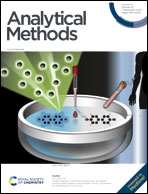A LoC-SERS platform based on triple signal amplification for highly sensitive detection of colorectal cancer miRNAs†
Abstract
In this work, based on a dual signal amplification strategy of enzyme-assisted signal amplification (EASA) and catalytic hairpin assembly (CHA), combined with the magnetic attraction effect, a capillary pump-driven surface-enhanced Raman scattering (SERS) microfluidic chip (LoC-SERS) platform was developed for the sensitive detection of colorectal cancer-associated (CRC) microRNA (miRNA). During the detection process, the miRNA first undergoes an EASA reaction with hairpin DNA1 (hpDNA1) under the action of endonuclease, which generates a large amount of DNA2 cyclically. After that, DNA2 triggers the CHA reaction to proceed, which leads to the ligation of the SERS nanoprobes and the capture nanoprobes (hpDNA2–hpDNA3 complexes). Finally, as the reactant solution flows through the collection zone, the end products are magnetically attracted by the micro-magnets, generating many “hot spots” and leading to a triple amplification of the SERS signal. By quantitative analysis, the platform achieved ultra-low detection limits of miR-122 (4.26 aM) and miR-192 (4.71 aM) within a linear range of 10 aM–10 pM. In addition, the platform's results for clinical samples are highly consistent with those measured by qRT-PCR methods. Overall, the proposed LoC-SERS platform is expected to be an important tool for the early screening of CRC.



 Please wait while we load your content...
Please wait while we load your content...